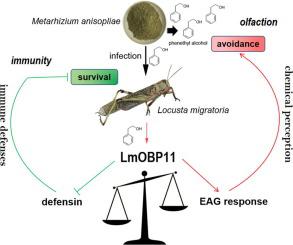Journal of Advanced Research ( IF 11.4 ) Pub Date : 2022-09-05 , DOI: 10.1016/j.jare.2022.08.013 Wei Zhang 1 , Mushan Xie 2 , Ioannis Eleftherianos 3 , Amr Mohamed 4 , Yueqing Cao 2 , Baoan Song 5 , Lian-Sheng Zang 5 , Chen Jia 5 , Jing Bian 2 , Nemat O Keyhani 6 , Yuxian Xia 2

|
Introduction
Odorant-binding proteins (OBPs) are a class of small molecular weight soluble proteins that exist as expanded gene families in all insects, acting as ligand carriers mediating olfaction and other physiological processes. During fungal infection, a subset of insect OBPs were shown to be differentially expressed.
Objectives
We tested whether the altered expression of insect OBPs during pathogenic infection plays a role in behavioral or immune interactions between insect hosts and their pathogens.
Methods
A wide range of techniques including RNAi-directed knockdown, heterologous protein expression, electrophysiological/behavioral analyses, transcriptomics, gut microbiome analyses, coupled with tandem mass spectrometry ion monitoring, were used to characterize the function of a locust OBP in host behavioral and immune responses.
Results
The entomopathogenic fungus Metarhizium anisopliae produces the volatile compound phenylethyl alcohol (PEA) that causes behavioral avoidance in locusts. This is mediated by the locust odorant binding protein 11 (LmOBP11). Expression of LmOBP11 is induced by M. anisopliae infection and PEA treatment. LmOBP11 participates in insect detection of the fungal-produced PEA and avoidance of PEA-contaminated food, but the upregulation of LmOBP11 upon M. anisopliae infection negatively affects the insect immune responses to ultimately benefit successful mycosis by the pathogen. RNAi knockdown of LmOBP11 increases the production of antimicrobial peptides and enhances locust resistance to M. anisopliae infection, while reducing host antennal electrophysiological responses to PEA and locust avoidance of PEA treated food. Also, transcriptomic and gut microbiome analyses reveal microbiome dysbiosis and changes in host genes involved in behavior and immunity. These results are consistent with the elevated expression of LmOBP11 leading to enhanced volatile detection and suppression of immune responses.
Conclusion
These findings suggest a crosstalk between olfaction and immunity, indicating manipulation of host OBPs as a novel target exploited by fungal pathogens to alter immune activation and thus promote the successful infection of the host.
中文翻译:

气味结合蛋白参与抵消检测避免和 Toll 通路先天免疫
介绍
气味结合蛋白 (OBP) 是一类小分子量可溶性蛋白,作为扩展的基因家族存在于所有昆虫中,充当介导嗅觉和其他生理过程的配体载体。在真菌感染期间,一部分昆虫 OBP 显示出差异表达。
目标
我们测试了病原体感染期间昆虫OBP表达的改变是否在昆虫宿主与其病原体之间的行为或免疫相互作用中发挥作用。
方法
广泛的技术,包括 RNAi 定向敲低、异源蛋白表达、电生理/行为分析、转录组学、肠道微生物组分析,以及串联质谱离子监测,被用于表征蝗虫OBP在宿主行为和免疫反应中的功能.
结果
昆虫病原真菌Metarhizium anisopliae产生挥发性化合物苯乙醇 (PEA),导致蝗虫行为回避。这是由蝗虫气味结合蛋白 11 ( LmOBP11 ) 介导的。LmOBP11的表达由M诱导。anisopliae感染和 PEA 治疗。LmOBP11参与昆虫检测真菌产生的 PEA 和避免 PEA 污染的食物,但LmOBP11对M的上调。anisopliae感染对昆虫免疫反应产生负面影响,最终有利于病原体成功的真菌感染。LmOBP11的 RNAi 敲低增加抗菌肽的产生并增强蝗虫对支原体的抗性。anisopliae感染,同时减少宿主触角对 PEA 的电生理反应和蝗虫避免 PEA 处理的食物。此外,转录组学和肠道微生物组分析揭示了微生物组生态失调以及与行为和免疫相关的宿主基因的变化。这些结果与LmOBP11的表达升高一致,导致增强的挥发性检测和免疫反应的抑制。
结论
这些发现表明嗅觉和免疫之间存在串扰,表明操纵宿主 OBP 作为真菌病原体利用的新靶点来改变免疫激活,从而促进宿主的成功感染。











































 京公网安备 11010802027423号
京公网安备 11010802027423号